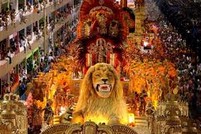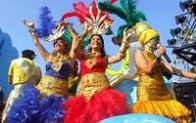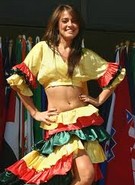你可曾为巴西狂欢节上的奔放与不羁所震撼?你可曾为巴西人对足球的狂热与痴迷所感染?你可曾为巴西香飘四溢的烤肉而垂涎?巴西,这个有着“南美巨人”之称的神秘国度到处都洋溢着热情和狂野的气息。本文将要带你领略的正是独一无二的巴西风情。
Brazil is blessed with one of the most fascinating cultures in the world. It’s the only Portuguese speaking country in South America and the people here have managed to blend elements of many diverse cultures into one incredible mix that is unique in its uninhibited1) flair2) and passionate way of life. Now let’s take a look at a few of the country’s wonderful cultural icons.
巴西文化是世界上最具魅力的文化之一。巴西是南美洲唯一说葡萄牙语的国家。巴西人成功地将多种不同的文化元素融合在一起,造就了一种不可思议的“熔炉文化”。这一文化因其狂野不羁的独特风格和充满激情的生活方式而显得与众不同。现在,就让我们一起来了解一些奇妙的巴西文化符号。
 Carnival is undoubtedly the most popular celebration in Brazil and it is celebrated in all of Brazil’s cities. Carnival expresses the culture, history, music, and images of Brazil.
Carnival is undoubtedly the most popular celebration in Brazil and it is celebrated in all of Brazil’s cities. Carnival expresses the culture, history, music, and images of Brazil.
狂欢节无疑是巴西最受欢迎的节日庆典。节日到来时,巴西所有的城市都举行狂欢。狂欢节是巴西的文化、历史、音乐以及国家形象的体现。
The event and the parade which takes place in Rio de Janeiro3) is the most famous and richest carnival in Brazil and maybe in the whole world. A million tourists join millions of Rio de Janeiro residents in the world’s most fantastic party spanning several days and nights. From the Friday before Ash Wednesday4) to the following Thursday, the whole city shuts down5) for a wild celebration.  里约热内卢举行的庆祝活动和狂欢游行是巴西最负盛名、最丰富多彩的狂欢节庆典,也许在全世界范围内亦是如此。上百万的游客与里约热内卢的数百万居民一起加入到这一全世界最为美妙的聚会中,享受长达几昼夜的狂欢。从圣灰星期三前的星期五到下一周的星期四,里约热内卢全城停止正常的运转,全情投入到疯狂的庆典中。
里约热内卢举行的庆祝活动和狂欢游行是巴西最负盛名、最丰富多彩的狂欢节庆典,也许在全世界范围内亦是如此。上百万的游客与里约热内卢的数百万居民一起加入到这一全世界最为美妙的聚会中,享受长达几昼夜的狂欢。从圣灰星期三前的星期五到下一周的星期四,里约热内卢全城停止正常的运转,全情投入到疯狂的庆典中。
The origin of Brazil’s carnival goes back to a Portuguese pre-Lent6) festivity called “Entrudo”. Entrudo was a chaotic three-day street event where people in masks threw water, flour, and mud at each other and that often led to riots.
巴西狂欢节起源于葡萄牙大斋节前的一个名为 “恩特鲁多”的欢庆活动。“恩特鲁多”是一种在街头举行的庆典活动,为期三天,庆典场面混乱。在活动期间,人们戴着面具,相互泼洒水、面粉和泥浆,常常引起骚乱。
In 1840, the Italian wife of a Rio de Janeiro hotel owner changed the carnival celebration forever by sending out invitations, hiring musicians, importing streamers7) and confetti8), and giving a lavish masked ball. Carnival street parades followed a decade later with horse-drawn floats9) and military bands.
1840年,里约热内卢一位旅馆老板的意大利籍妻子在狂欢节庆典期间发放请帖,雇请音乐师,引进五彩缤纷的彩带和纸屑,并且举办盛大的假面舞会,从而永久地改变了狂欢节的庆祝方式。十年后,狂欢节上出现了街头游行,游行队伍中有马拉彩车,还有军乐队。
 The carnivals reached a peak around 1930 when the samba schools started to emerge in Rio de Janeiro. The samba is a unique Brazilian music and a dance form that was begun by the poor Afro-Brazilians. It grew out of the Angolan word “samba”, which translates as pelvic10) movements and the African rite of reproduction. The movements in this samba developed out of the polka, tango, waltz, and another samba music called Choro11).
The carnivals reached a peak around 1930 when the samba schools started to emerge in Rio de Janeiro. The samba is a unique Brazilian music and a dance form that was begun by the poor Afro-Brazilians. It grew out of the Angolan word “samba”, which translates as pelvic10) movements and the African rite of reproduction. The movements in this samba developed out of the polka, tango, waltz, and another samba music called Choro11).
1930年前后,里约热内卢开始出现桑巴舞学校,狂欢节也由此进入了一个巅峰时期。桑巴是巴西一种独特的音乐和舞蹈形式,是由非洲裔的巴西穷人们创造出来的。“桑巴”这一名称源于安哥拉语“samba”一词,意为骨盆运动,表示非洲的一种生殖仪式。桑巴舞的舞蹈动作是从波尔卡舞、探戈、华尔兹以及另一种名为“啼乐”的桑巴音乐发展而来的。
Nowadays Rio’s Carnival is the most impressive and best-organized carnival in Brazil. The highlight of the carnival is the Parade at Marques de Sapucai, where different samba schools fight for the title of Carnival Champion. Samba rhythms, fantastic dancers, splendid costumes, live colors, and beautiful women are the main ingredients of this great competition. Some of the greatest parts of the carnival are that it also provides entertainment for many people around the world, and it gives others a chance to learn about the culture of Brazil.
现在,里约热内卢的狂欢节是巴西场面最壮观、组织最好的狂欢庆典。庆典最精彩的部分是在萨普凯侯爵大道上的狂欢游行,各个桑巴舞学校都云集于此,争夺“狂欢节冠军”的头衔。桑巴舞旋律、迷人的舞者、华丽的服装、鲜活的色彩以及漂亮的女人构成了这场盛大比赛的主旋律。狂欢节最棒的一点还在于,它为来自全世界各地的许多人带来了欢乐,同时也为他们提供了一个了解巴西文化的机会。
 Without any doubt, Brazil is one of the biggest soccer countries in the world. For millions of Brazilians, soccer is a“way of life” and plays an important role in their social life.
Without any doubt, Brazil is one of the biggest soccer countries in the world. For millions of Brazilians, soccer is a“way of life” and plays an important role in their social life.
毫无疑问,巴西是世界上的足球大国之一。对于数百万的巴西人来说,足球是一种“生活方式”,在他们的社交生活中扮演着重要的角色。
Soccer was brought to Brazil in 1885 by the Englishman Charles Miller. It started as a game played only by rich boys in private clubs. After decades of discrimination against poor or black people, soccer changed into a professional activity in 1933 and after this it became very popular in schools, factories and clubs. Soccer was played throughout the country on beaches or fields, and with its popularity, it was especially practiced by the low-income population.
足球运动是由英国人查尔斯·米勒于1885年带入巴西的。起初,足球只是私人俱乐部中富家男孩参与的一项运动。直到1933年,在对穷人和黑人的歧视持续了几十年后,足球才开始转变为一项专业运动,风靡于学校、工厂以及俱乐部中。在巴西全国各地的海滩或空地上,到处都有人踢足球。由于足球的大众性特征,它尤其受到低收入群体的青睐。
 The way soccer is played in Brazil is unique. Its style is the result of the rhythm and coordination from the Afro-Brizilians. This unique quality was a characteristic of slaves that developed the capoeira12), Brazilian martial arts13) and samba, which are characterized by footsteps to dance or to play under the rhythm of African drums.
The way soccer is played in Brazil is unique. Its style is the result of the rhythm and coordination from the Afro-Brizilians. This unique quality was a characteristic of slaves that developed the capoeira12), Brazilian martial arts13) and samba, which are characterized by footsteps to dance or to play under the rhythm of African drums.
巴西人踢足球的风格颇为独特。这种风格源自于非裔巴西人的节奏感和协调性。这一特质是那些曾创造出了巴西武术卡波卫勒战舞和桑巴舞的奴隶们所与生俱来的,其共同特点是舞步或步法都紧随非洲鼓乐的节奏。
The Brazil soccer team was the first team to win the World Cup five times in 1958, 1962, 1970, 1994, and 2002. Also Brazil has more professional soccer teams than any other country in the world. Great players such as Pele, Garrincha, Zico, Romario and Ronaldo started playing soccer on dirt fields under poor conditions. They turned into very good players known all over the world, which also made Brazil very famous.
巴西足球队是第一支曾五次摘得世界杯桂冠的球队,夺冠时间分别是在1958年、1962年、1970年、1994年和2002年。巴西所拥有的专业球队数量超过世界上其他任何国家。像贝利、加林查、济科、罗马里奥与罗纳尔多这样伟大的足球运动员,都是在条件艰苦的泥土场地上开始他们的足球生涯的。他们最终成为享誉全球的优秀球员,同时也成就了巴西的盛名。
Many poor boys are dreaming of becoming the next Pele or Ronaldo and because of this, they promote the national soccer culture even more. Dreaming about soccer is a motivation for millions of children, who want to escape from their poverty. They combine the fun of soccer with living in poverty. It’s even so that the soccer culture has a bigger influence on the Brazilian life than for example politics or economics.
许多穷苦的男孩都梦想着成为下一个贝利或罗纳尔多,他们也因此进一步推动了巴西的足球文化。对于那些想摆脱贫穷的数百万孩子来说,足球梦就是他们奋斗的一种动力。这些孩子将足球的乐趣融入到贫困的生活中。也正因为如此,与诸如政治、经济等因素相比,足球文化对巴西人生活所产生的影响更为深远。
 More than 400 years ago cattle ranching14) was introduced to the Rio Grande do Sul region of Brazil. Cowboys, called Gauchos, herded15) these cattle, and created a new style of cooking. They called it Churrasco, which is Brazilian Barbecue. Churrasco started in the 16th and 17th centuries and spread throughout all of Brazil in the 1940’s as the Gauchos spread across the country.
More than 400 years ago cattle ranching14) was introduced to the Rio Grande do Sul region of Brazil. Cowboys, called Gauchos, herded15) these cattle, and created a new style of cooking. They called it Churrasco, which is Brazilian Barbecue. Churrasco started in the 16th and 17th centuries and spread throughout all of Brazil in the 1940’s as the Gauchos spread across the country.
四百多年前,用牧场养牛的方法传到了巴西的南里奥格兰德地区。名为高卓人的牧民在此放牧养牛时,创造出了一种新的烹饪方式,称之为“Churrasco”,这就是巴西烧烤。巴西烧烤源于16和17世纪,到了20世纪40年代,随着高卓人的足迹遍布全国,巴西烧烤也随之走向全国各地。
Originally the standard formula for Brazilian style barbecue was to coat meats in coarse16) salt. The meat would then sit for about 30 minutes to absorb the salt and then was placed over the fire. Later a salt-water baste17) was used to keep meats moist18)during the cooking. Beef was typically never seasoned19). Poultry20) and lamb, however, are spiced with a rich marinade21) the night before cooking. Meats are places on long sword-like skewers and cooked over an open fire. Nowadays with the growing popularity of this style of grilling you can even buy a churasco grill.
最初的时候,巴西烧烤的标准烤制方法如下:首先将肉块裹上一层粗盐,放置大约三十分钟以使其充分吸收盐分,然后把肉块放在炉火上烤制;过一会儿,再将咸味酱汁泼洒在肉块上,以使肉块在烧烤过程中保持湿润;通常情况下,牛肉不用添加任何调味料,不过禽肉与羊羔肉须在烧烤的前夜放入浓腌泡汁中入味;人们把肉块串在长长的剑形烤肉叉上,然后置于明火上烧烤。如今,随着这种烧烤方式越来越受到人们的青睐,人们甚至可以买到巴西烤肉架来烧烤。
Churrasco is much more than a way of cooking in Rio Grande do Sul. It’s a way of life. The Barbecue capital of Brazil is the city of Nova Brescia which has a statue of a man cooking barbecue in the central plaza22). In the 1940’s this city had a population of about 150,000. Since then the population has dropped to about 30,000 due to the mass exodus23) of people leaving to open Barbecue restaurants across Brazil. The popularity of Brazilian Barbecue has lead to the founding of dozens of restaurants, popping24) up all over the world.
在南里奥格兰德,巴西烧烤不仅仅是一种烹饪方法,更是一种生活方式。巴西的“烧烤之都”是新布雷西亚,在该市的中心广场上就屹立着一尊正在烤肉的男子雕像。20世纪40年代,南里奥格兰德市的人口约有十五万。后来,随着大量的居民前往巴西各地开烧烤店,该市的人口锐减,只剩下三万人左右了。巴西烧烤的盛行带动了烤肉店的兴旺,全世界的巴西烤肉店如雨后春笋般四处涌现。
More than a typical food, the churrasco is kind of institution among Brazilians. Important events (weddings, anniversaries, football victories) are often celebrated with a churrasco, which start in the morning and goes into the night.
巴西烧烤不仅是巴西的代表性食物,它在某种意义上已成为巴西人的一种习俗。人们在举行重大的庆祝活动(诸如婚礼、周年纪念、足球胜利庆典)时,通常会设有巴西烧烤,烧烤从清早一直持续到夜晚。
Brazilian culture wouldn’t survive without a beach nearby. In Brazil the beach is not just a place to go for recreation or sport, it is a way of life. Brazilians have an obsession with their beach culture.
如果没有海滩,巴西文化就会消亡。在巴西,海滩不仅仅是娱乐或运动的场所,更是一种生活方式。巴西人对自己的海滩文化十分迷恋。
 Brazilian beaches by nature’s design and reputation are extraordinary: thousands of miles of changing landscape and scenery replete25) with crashing waves for the ardent surfer and calm emerald26) coves for the leisurely traveler. Up and down the thousands of miles of Brazilian coastline lie literally thousands of beaches, from the internationally famous to the seductively secluded27).
Brazilian beaches by nature’s design and reputation are extraordinary: thousands of miles of changing landscape and scenery replete25) with crashing waves for the ardent surfer and calm emerald26) coves for the leisurely traveler. Up and down the thousands of miles of Brazilian coastline lie literally thousands of beaches, from the internationally famous to the seductively secluded27).
巴西海滩自然风光一流,名气亦不同凡响:数千英里的风景不断变幻,滚滚海浪连绵不绝,沉静的、翠绿色的小海湾数不胜数,不管是激情的冲浪者还是悠闲的游客,都能各得其所。在巴西数千英里的海岸线上,散布着数千处海滩,有世界闻名的,也有令人神往、僻静隐蔽的。
No one knows how to make the most out of a beach as well as the Brazilians do. It is justifiably called a “culture”. All of the beaches of Brazil though are not for all of the people wishing to visit them. Each has their own quirks and characteristics. Many are easily accessible by public transportation and are surrounded by creature comforts we’ve come to expect and enjoy. Others are extremely remote, isolated, pristine28) and unspoiled by the hands of man. Each has its own sense of history and appeal. Exploring the opportunity to touch the confluence of sun, sand and sea in so many unique and original ways can be not only invigorating but also relaxing, enlightening, spiritually refreshing and just plain fun.
巴西人知道如何充分利用海滩,在这一点上无人能与之匹敌,将其称做“文化”一点也不为过。然而,并不是所有的巴西海滩都适合想去参观的人。每一个海滩都有其独特之处。有许多海滩依靠公共交通就很容易到达,周围也全是我们期望进行物质享受的场所;而有些海滩却极其遥远、偏僻,未经人类开发,也未受到人类的破坏。每一处海滩都展现了其独特的历史与魅力。抓住机会,以众多独特新颖的方式同时感受阳光、沙滩以及海洋的魅力,不仅使人充满活力,也会让人身心放松、精神焕发,同时还会得到实实在在的快乐。
1. uninhibited [7QnIn5hIbItId] adj. 放荡不羁的,不受抑制的 2. flair [fleə] n. 天资,才能,特殊的才干
3. Rio de Janeiro [5ri(:)Eu dE dVE5nIErEu] n. 里约热内卢,巴西东南部港市
4. Ash Wednesday:圣灰星期三(复活节前的第七个星期三)
5. shut down:(使)关闭,(使)停工
6. Lent [lent] n. [宗] 大斋节(指复活节前为纪念耶稣在荒野禁食而进行的为期40天的斋戒及忏悔)
7. streamer [5stri:mE] n. 彩色纸带,飘带 8. confetti [kEn5fetI] n. (婚礼、狂欢节中抛撒的)五彩纸屑
9. float [flEut] n. 彩车 10. pelvic [5pelvIk] adj. [解] 骨盆的
11. Choro:啼乐,巴西音乐中一种重要的音乐类型,起源于1860至1870年巴西的里约热内卢。之所以叫“啼乐”,是因为它最初的曲风较为低沉哀伤、多愁善感,但后来逐渐发展成为愉悦欢快的风格。
12. capoeira [7kB:pE5weIrE] n. 卡泼卫勒战舞(一种把民间舞蹈和自卫动作结合在一起的巴西舞蹈,源于非洲)
13. martial arts:武术(指功夫、柔道、空手道) 14. ranch [rAntF, rB:ntF] vi. 经营牧场
15. herd [hE:d] vt. 把……赶在一起放牧 16. coarse [kC:s] adj. 粗的,粗粒的
17. baste [beIst] n. 油脂(如溶化了的奶油或酱汁) 18. moist [mCIst] adj. 潮湿的,湿润的
19. season [5si:zn] vt. 给……加调味料 20. poultry [5pEultrI] n. 家禽
21. marinade [7mArI5neId] n. 腌泡汁 22. plaza [5plB:zE] n. 广场
23. exodus [5eksEdEs] n. (大群人的)离开 24. pop [pCp] vi. (突然)冒出
25. replete [rI5pli:t] adj. 充满的,装满的 26. emerald [5emErEld] adj. 翡翠的,翠绿色的
27. secluded [sI5klu:dId] adj. 隐退的,隐蔽的 28. pristine [5prIstaIn] adj. 原始的,未被文明腐蚀的
